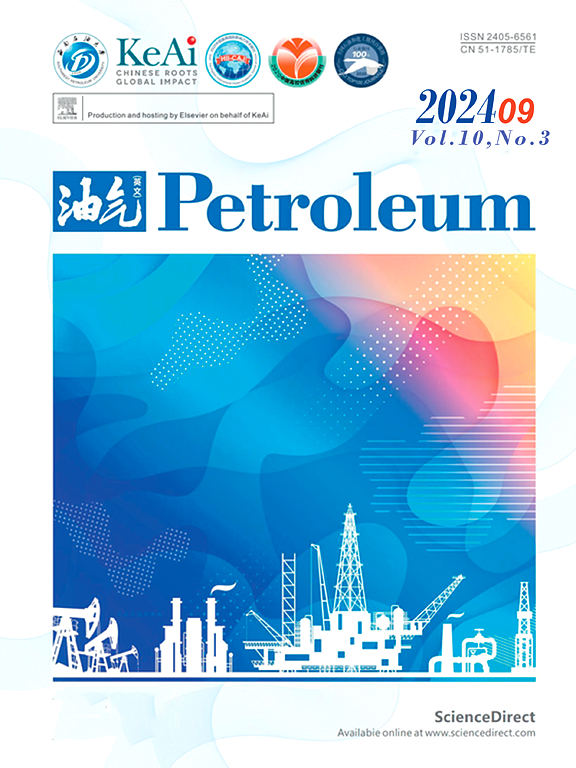研究了砂岩储层热解反应对储层原位产氢的影响
IF 3.5
Q2 ENERGY & FUELS
引用次数: 0
摘要
原位燃烧气化(ISCG)是一项用于油藏制氢的现场试验技术。ISCG是通过向储层注入氧化剂(纯氧、空气等)来触发现场化学反应,从而产生氢气。热解反应是原位燃烧(ISC)引发的重要反应之一。本研究采用固定床微活性测试装置(MAT)对原油热解制氢进行了研究。在MAT装置中进行了不同温度(300℃、400℃、500℃、600℃)、常压和氮气流下的原油热解实验。结果表明:该反应的起始温度为500℃左右;实验表明,砂岩的引入促进了高温下的产氢和焦炭的形成。在600℃时,有砂岩效应的氢气生成量最大达到8.15 mL,而没有砂岩效应的氢气生成量在600℃时仅为6.39 mL。该研究为原油原位热解制氢提供了深入的认识。此外,所获得的各种热解产物数据提供了原油热解的全面表征,可以促进现有的原油原位气化制氢反应模型。研究结果表明,采用原油热解法直接产氢是可行的。本文章由计算机程序翻译,如有差异,请以英文原文为准。
An experimental study to investigate the role of pyrolysis reaction on in-situ hydrogen generation from sandstone oil reservoirs
In-situ combustion gasification (ISCG) is a technology in the field pilot stage used for hydrogen generation from oil reservoirs. ISCG is implemented by injecting an oxidant (pure oxygen, air, …) into the reservoir to trigger in-situ chemical reactions responsible for hydrogen generation. Pyrolysis reaction is one of the significant reactions triggered by in-situ combustion (ISC). This study used a fixed-bed micro-activity test (MAT) unit to investigate hydrogen generation from crude oil through pyrolysis. Crude oil pyrolysis experiments were conducted in the MAT unit under different temperatures (300 °C, 400 °C, 500 °C, 600 °C), atmospheric pressure, and under a flow of a nitrogen gas. The results showed that the threshold initiation temperature of hydrogen generation and coke formation was about 500 °C. The experiments demonstrated that the introduced sandstone enhanced hydrogen generation and coke formation at high temperatures. The maximum volume of hydrogen generated with sandstone effect reached 8.15 mL at 600 °C, while that without sandstone was only 6.39 mL at 600 °C. The study provides deep insights into the in-situ hydrogen generation from crude oil through pyrolysis. In addition, the obtained data of various pyrolysis products provide a comprehensive representation of crude oil pyrolysis that could promote the existing reaction models of in-situ hydrogen generation from the gasification of crude oil. The findings demonstrate the potential of adopting pyrolysis of crude oil for direct hydrogen generation from reservoirs.
求助全文
通过发布文献求助,成功后即可免费获取论文全文。
去求助
来源期刊

Petroleum
Earth and Planetary Sciences-Geology
CiteScore
9.20
自引率
0.00%
发文量
76
审稿时长
124 days
期刊介绍:
Examples of appropriate topical areas that will be considered include the following: 1.comprehensive research on oil and gas reservoir (reservoir geology): -geological basis of oil and gas reservoirs -reservoir geochemistry -reservoir formation mechanism -reservoir identification methods and techniques 2.kinetics of oil and gas basins and analyses of potential oil and gas resources: -fine description factors of hydrocarbon accumulation -mechanism analysis on recovery and dynamic accumulation process -relationship between accumulation factors and the accumulation process -analysis of oil and gas potential resource 3.theories and methods for complex reservoir geophysical prospecting: -geophysical basis of deep geologic structures and background of hydrocarbon occurrence -geophysical prediction of deep and complex reservoirs -physical test analyses and numerical simulations of reservoir rocks -anisotropic medium seismic imaging theory and new technology for multiwave seismic exploration -o theories and methods for reservoir fluid geophysical identification and prediction 4.theories, methods, technology, and design for complex reservoir development: -reservoir percolation theory and application technology -field development theories and methods -theory and technology for enhancing recovery efficiency 5.working liquid for oil and gas wells and reservoir protection technology: -working chemicals and mechanics for oil and gas wells -reservoir protection technology 6.new techniques and technologies for oil and gas drilling and production: -under-balanced drilling/gas drilling -special-track well drilling -cementing and completion of oil and gas wells -engineering safety applications for oil and gas wells -new technology of fracture acidizing
 求助内容:
求助内容: 应助结果提醒方式:
应助结果提醒方式:


